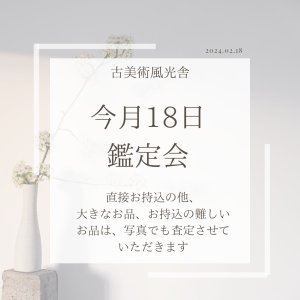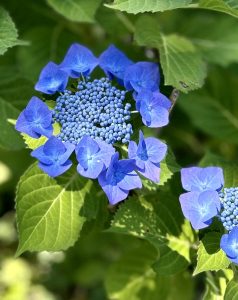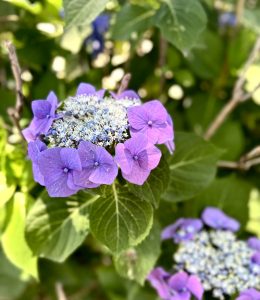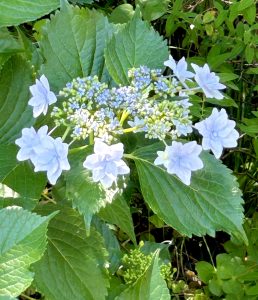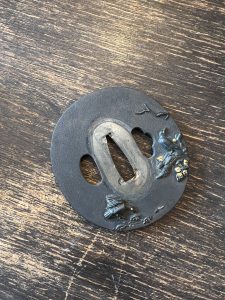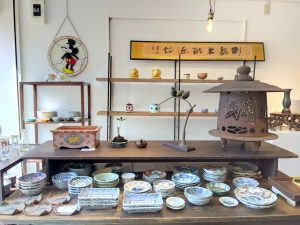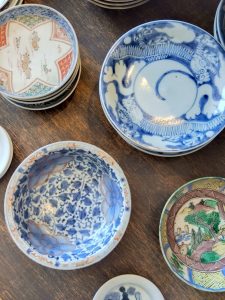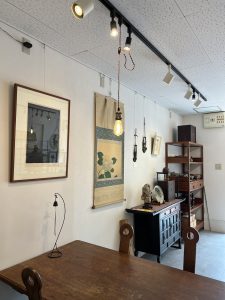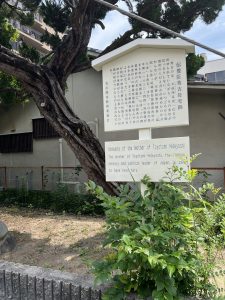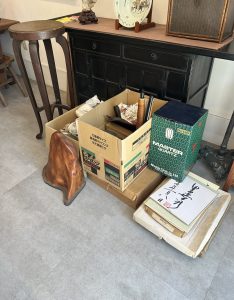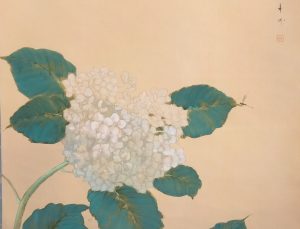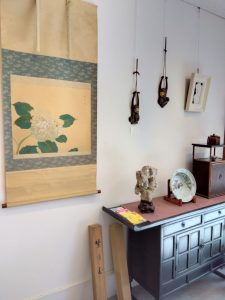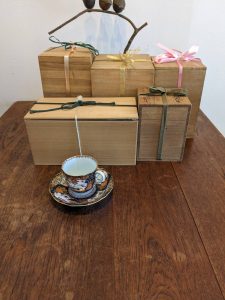皆さまこんにちは。スタッフHでございます。
さて本日は、家のお片付けの際に処分に困るお品の中でご相談が多い「象牙」の取り扱いについて綴りたいと思います。
象牙は古代から貴重な品として扱われ、適度な硬質と加工しやすい柔らかさを兼ね備えていることから古より彫刻作品、骨董品、家具、装飾品などに用いられました。多くの哺乳類の牙は犬歯が発達したものですが、象牙は門歯が発達したものです。
象牙色とはアイボリーとも呼ばれ、黄味がかった淡い色が特徴です。乳白色の滑らかな肌合いや、年を経て生まれる温かみのある飴色の質感が人々を魅了してきました。象牙にはロゼット模様と呼ばれる特徴的な縞目模様があり、象牙の真贋を鑑別する目安となっています。また先端にいくほど、中心に近いものほど貴重とされています。
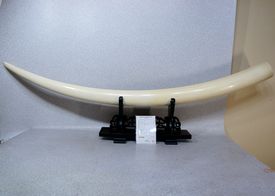
象牙工芸品の扱う際の注意点などについて簡単に説明させていただきます。
1.ワシントン条約による規制
中世の時代までは、アフリカの自然死した象から採取した象牙が利用されていたと考えられています。しかしその美しさや加工のしやすさから、象牙を目的とした象の乱獲が進みました。そのため20世紀初頭に1000万頭いたアフリカ象は65万頭に激減しました。この事態に危機感を持ち、1989年ワシントン条約により象牙の国際取引が禁止されました。これ以前に国内で所有されていた象牙、またはその加工品のみ譲渡・売買が許可されています。
2.登録票の取得
個人の所有も含め、象牙の原型をとどめている1本物は登録票がないと譲渡・売買ができません。たとえ彫り物がしてあっても、原型が残っている象牙は環境省に登録する必要があります。
この「国際希少野生動物種登録票」がなければ所有することができません。ただし、加工されていて原型が残っていない象牙製品は該当しません。
3.象牙を取り扱える業者
2018年6月1日より、国内での象牙製品の違法な取引を防ぐため「絶滅のおそれのある野生動植物の種の保存に関する法律」(種の保存法)の改正法が施行され、日本国内で象牙製品等の製造販売をおこなう事業者は、経済産業省へ「特別国際種事業者」として届け出を行い、5年ごとに更新が必要となりました。
またこの登録を怠ったり、「種の保存法」に違反する取引などを行った際の罰則が強化され、懲役刑も求刑されることとなりました。
4.象牙工芸品
日本には奈良時代に中国から象牙を彫る技法が伝えられたとされています。江戸時代には根付、髪飾り、櫛などの象牙工芸品が武士や庶民に愛用され、次第にその芸術性を高めていきました。
明治時代には殖産興業の一環として技巧を凝らした象牙工芸品が国際博覧会にも出展されました。 大正、昭和に入ると、西欧のパイプが伝わり象牙の喫煙具が作られ、近代では印鑑、和楽器等にも使用されています。
5.著名な象牙作家
象牙工芸品の芸術性の高まりと共に、象牙を彫る作家、牙彫作家と呼ばれる人々も現れました。その中から何人かご紹介いたします。
・旭玉山(1843-1923)
東京の浅草の寺に生まれ、一旦は僧侶となりましたが独学で彫刻を勉強し、カエルや犬、蜘蛛などの生物を題材として緻密に彫られた根付を制作していました。明治に入ると人骨に興味を示し、制作した「どくろ」の根付が好評を博しました。博覧会の審査員も勤めたのち、1901年に日本美術協会に出展した「官女置物」はいくつもの牙材を接合して制作された大作で高い評価を受けました。
・石川光明(1852-1913)
寺社仏閣の建築を担う宮大工の家に生まれ、その技術をもとに彫刻家として活躍しました。旭玉山と共に後の「東京彫工会」となる彫刻の研究会を始めました。代表作に「古代鷹狩置物」があり、1900年のパリ万国博覧会に出品され、まさに鷹を放つ瞬間を表していると評価されています。
・安藤緑山(1885-1955)
大正から昭和初期に牙彫作家として活動し、野菜や果物など身近なものを題材とした50点余りの作品を残しています。
超絶技巧、スーパーリアリズムと称され、象牙に着色を施しているという特徴があります。当時は白地の肌合いが牙彫の王道でしたが、「象牙に色をのせると色が滲んで独特の味わいが出る」という緑山独自の流儀で鮮やかな色を施しました。しかし主流から外れるとして当時はその高い技巧に対して評価されることはありませんでした。
21世紀に入り緑山の工芸品は「超絶技巧」ともてはやされ知名度が上がることとなります。代表作とされる「竹の子、梅」は本物と見間違えるほどの緻密さで作られており、竹の子の産毛までもが繊細に表現されています。
象牙製品は高級な嗜好品ですので、査定を受ける際には特別国際種事業者として認定されているお店を選ぶことが重要です。ご自宅にある象牙の価値はどのくらいだろう?と疑問に思われましたら、信用のある業者で一度鑑定してもらうことをお勧めします。
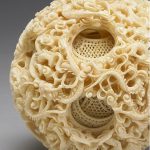
Hello everyone. This is Staff H.
Today, I would like to write about the handling of “ivory,” which is often consulted among the items that are difficult to dispose of when cleaning out one’s house.
Ivory has been treated as a precious article since ancient times, and has been used for sculptures, antiques, furniture, and ornaments since ancient times because it has both moderate hardness and softness that can be easily processed. The tusks of most mammals have well-developed canine teeth, while ivory has well-developed portal teeth.
Ivory, also called ivory, is characterized by a light yellowish color. The smooth milky-white skin and the warm candy-colored texture produced by age have attracted people. Ivory has a characteristic stripe pattern called rosette pattern, which is a standard to distinguish the authenticity of ivory. Also, the further to the tip, the closer to the center, the more valuable it is considered.
I will briefly explain the points to be noted when handling ivory artifacts.
Regulations by Washington Convention
It is thought that ivory taken from elephants that died of natural causes in Africa was used until the Middle Ages. However, due to their beauty and ease of processing, elephants were overhunted for their ivory. As a result, the number of African elephants, which had numbered 10 million at the beginning of the 20th century, plummeted to 650,000. With a sense of crisis, the international trade of ivory was banned by the Washington Convention in 1989. Only ivory or its processed products that were owned domestically before this treaty are allowed to be transferred and sold.
2. obtaining a registration card
The transfer and sale of one original ivory that retains its original form, including private ownership, is not allowed without a registration slip. Even if it is carved, ivory that still retains its original form must be registered with the Ministry of the Environment.
Without this “International Rare Wildlife Species Registration Card”, you cannot own it. However, ivory products that have been processed and do not retain their original form do not fall under this category.
3. ivory can be handled by the following companies
From June 1, 2018, in order to prevent illegal trade of ivory products in Japan, the revised “Law for Conservation of Endangered Species of Wild Fauna and Flora” (Law for Conservation of Species) has been enforced, and businesses that manufacture and sell ivory products, etc. in Japan are required to notify the Ministry of Economy, Trade and Industry as a “Special International Species Business Operator,” and renew the registration every 5 years In addition, if they fail to register as a “Special International Type Business Operator”, they are required to renew their registration every five years.
In addition, the penalties for failing to register or engaging in transactions that violate the “Law for the Conservation of Species” have been strengthened, and prison sentences are now also sought.
4.Ivory Crafts
It is said that the technique of carving ivory was introduced to Japan from China in the Nara period (710-794). In the Edo period, ivory crafts such as netsuke, hair ornaments, and combs were favored by samurai and common people, and their artistic value was gradually enhanced.
In the Meiji period (1868-1912), elaborate ivory crafts were exhibited at international expositions as part of the industrial development industry. In the Taisho and Showa periods, Western pipes were introduced and ivory smoking implements were made. In modern times, ivory is also used for seals and Japanese musical instruments.
5. famous ivory artists
With the increase in the artistry of ivory crafts, there appeared artists who carved ivory, called “tusk carvers”. Some of them are introduced below.
Asahi Gyokusan (1843-1923)
He was born in a temple in Asakusa, Tokyo, and once became a Buddhist priest, but taught himself to carve, producing elaborately carved netsuke with frogs, dogs, spiders, and other creatures as his subjects. In the Meiji era (1868-1912), he became interested in human bones, and his “dokuro” netsuke were well received. After serving as a juror at expositions, he exhibited his “Kannjo Okimono” at the Japan Art Association in 1901, a large work made by joining several pieces of tusk wood, which was highly acclaimed.
Mitsuaki Ishikawa (1852-1913)
Born into a family of shrine carpenters responsible for building temples and shrines, Ishikawa became an active sculptor based on his skills. Together with Asahi Gyokusan, he started a sculpture study group that later became the “Tokyo Engraving Society. His representative work is “Ancient Hawk Hunting Ornament,” which was exhibited at the Paris Exposition of 1900 and was highly regarded as representing the very moment of releasing a hawk.
Ando Ryokuzan (1885-1955)
Active as a tusk carver from the Taisho era (1912-1926) to the early Showa era (1926-1989), Ando left more than 50 works featuring familiar objects such as vegetables and fruits.
His works are characterized by their superb technique and super-realism, and are characterized by the use of coloring on ivory. At that time, the royal road of tusk carving was to carve on a white surface, but in his own unique style, Midoriyama applied vivid colors, saying, “When colors are applied to ivory, they bleed into the ivory and produce a unique flavor. However, the high level of skill was not appreciated at the time because it was considered to be out of the mainstream.
In the 21st century, Ryokusan’s craftsmanship was praised as “superb technique,” and his fame increased. His representative work, “Bamboo shoots and plum blossoms,” is made with such precision that it could be mistaken for the real thing, and even the hairs of the bamboo shoots are delicately expressed.
Ivory products are high-class luxury goods, so it is important to choose a store that is certified as a special international species business when receiving an appraisal. How much is the value of the ivory in your home? If you wonder how much your ivory is worth, we recommend you to have it appraised once at a trustworthy business.
See you next time!
*******************
ご実家の整理やお片付けなどをされている方のご相談などが多くございます。
お片付けなどくれぐれもご無理のないようになさってくださいませ。
風光舎では古美術品や骨董品の他にも絵画や宝石、趣味のお品など様々なジャンルのものを買受しております。
お片付けをされていて、こういうものでもいいのかしらと迷われているものでも、どうぞお気軽にご相談下さいませ。
また風光舎は、出張買取も強化しております。ご近所はもちろん、愛知県内、岐阜県、三重県その他の県へも出張いたします。
まずは、お電話お待ちしております。
愛知県名古屋市千種区姫池通
骨董 買取【古美術 風光舎 名古屋店】
TEL052(734)8444
10:00-18:00 OPEN
